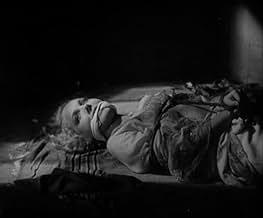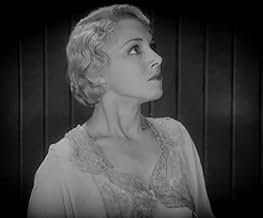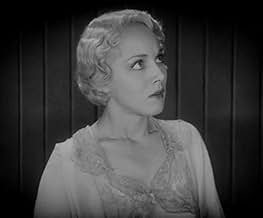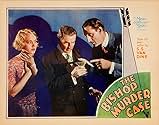Agrega una trama en tu idiomaWhen the body of a man nicknamed "Cock Robin" is found with an arrow in the heart on an archery range along with a chess bishop as a clue, Philo Vance investigates.When the body of a man nicknamed "Cock Robin" is found with an arrow in the heart on an archery range along with a chess bishop as a clue, Philo Vance investigates.When the body of a man nicknamed "Cock Robin" is found with an arrow in the heart on an archery range along with a chess bishop as a clue, Philo Vance investigates.
- Dirección
- Guionistas
- Elenco
Charles Quatermaine
- John Pardee
- (as Charles Quartermaine)
Sidney Bracey
- Pyne
- (as Sydney Bracey)
Richard Cramer
- Detective in Park
- (sin créditos)
Frank Fanning
- Officer Manning
- (sin créditos)
Marcia Mae Jones
- Hungry Child in Park
- (sin créditos)
Broderick O'Farrell
- Dr. Van Pelt
- (sin créditos)
- Dirección
- Guionistas
- Todo el elenco y el equipo
- Producción, taquilla y más en IMDbPro
Opiniones destacadas
Good effort given the primitive technology. This very early talkie does not creak like most of them did, and you believe that the same team could have done much better only a few years later.
Check out the innovative scene of Hyams at the three-way mirror. Beautiful scene that directors even today should view for technique. There are several little skilled touches added to this film that make you realize that the only limitation on the talent was the primitive lower-than-low tech.
Rathbone and Hyams seem more modern than the movie and they definitely do not creak.
Must reluctantly give it a "5" because of old set-bound look of the film and the lack of music but it is rewarding if you can overlook such drawbacks.
Check out the innovative scene of Hyams at the three-way mirror. Beautiful scene that directors even today should view for technique. There are several little skilled touches added to this film that make you realize that the only limitation on the talent was the primitive lower-than-low tech.
Rathbone and Hyams seem more modern than the movie and they definitely do not creak.
Must reluctantly give it a "5" because of old set-bound look of the film and the lack of music but it is rewarding if you can overlook such drawbacks.
When you consider that sound had only come in a couple of years before THE BISHOP MURDER CASE, the fact that the film still has a soundtrack that needs restoration is no surprise. But I did manage to see a good print of the film on TCM and the gleaming B&W photography belied the fact that this was made in 1930.
But my sole purpose for watching was to see what BASIL RATHBONE looked like in an early detective role as Philo Vance. The mystery itself seemed a lot like an Agatha Christie whodunit because the murders were staged by a clever killer who just wasn't smart enough to outwit Philo Vance. The final revelation involves a glass of wine with poison in it ("the vessel with the pessel" film that Rathbone did with Danny Kaye comes to mind here). Rathbone's cleverness and manner of solving the crime is reminiscent of the way he played Sherlock Holmes so well in all those Sherlock films.
He also had a crisp delivery that was lacking in the other players. Only ROLAND YOUNG managed to sound as if silent films were a thing of the past. The others were clearly still in the silent mode of acting which makes Rathbone's performance even more remarkable.
Not a great mystery by any means and the sets, despite some fine photography, are on the primitive side--but addicts of detective stories should enjoy this one.
But my sole purpose for watching was to see what BASIL RATHBONE looked like in an early detective role as Philo Vance. The mystery itself seemed a lot like an Agatha Christie whodunit because the murders were staged by a clever killer who just wasn't smart enough to outwit Philo Vance. The final revelation involves a glass of wine with poison in it ("the vessel with the pessel" film that Rathbone did with Danny Kaye comes to mind here). Rathbone's cleverness and manner of solving the crime is reminiscent of the way he played Sherlock Holmes so well in all those Sherlock films.
He also had a crisp delivery that was lacking in the other players. Only ROLAND YOUNG managed to sound as if silent films were a thing of the past. The others were clearly still in the silent mode of acting which makes Rathbone's performance even more remarkable.
Not a great mystery by any means and the sets, despite some fine photography, are on the primitive side--but addicts of detective stories should enjoy this one.
This was the third Philo Vance detective film, and the only one to star Basil Rathbone. William Powell played Vance in the two previous films (1929 and 1930) and the two succeeding ones (1930 and 1933). It is fascinating to see the young Rathbone nine years before he made his first Sherlock Holmes film, 'The Hound of the Baskervilles' (1939). He is very much 'Sherlock before Sherlock'. There are two amazing character actors in this one, George F. Marion and Zelda Sears as the Drukkers, brother and sister. What faces! That was when people looked different, not the same as now when everyone is the same. The director makes the most of them, and they certainly add an eerie dimension to this story. A lot of people get killed in this tale, though of course we do not see the blood and gore because it is only 1930, and it is all we can do to hear the early sound sometimes. Cedric Gibbons as Art Director did some bold sets, with enormously high windows and huge rooms. The film is creaky in many ways, but it is a ripping yarn. Try and figure this one out! This is perhaps the cinema's earliest portrayal of a serial killer, which goes to prove that nothing is new. It is not a whodunnit, it is a whodunn'em.
I recently learned that Willard Huntington Wright aka S.S. Van Dine the author of the Philo Vance mysteries sold the various screen rights to his stories one at a time to the various studios who would pay for them. It's the reason that Paramount, MGM, Warner Brothers and later the B independent Producer's Releasing Corporation all had a hand in the series and we have so many Philos to compare styles with.
Basil Rathbone takes his turn at Philo and the Philo he creates isn't too much different from Sherlock Holmes. He's got no Watson to be his scribe and record his genius, but otherwise he's the same clever fellow who found out the secret of that hound of the Baskervilles, etc.
S.S. Van Dine did create a dumb flatfoot of a police sergeant Heath for Vance to constantly show up. At Paramount and later at Warner Brothers it was Eugene Palette, here we have James Donlon who even the maid puts down regularly. I'm not sure what Heath is there for because the District Attorney just calls in Vance for help when there's an interesting case.
Here we have the discovery of a dead body found on an archery field with an arrow through him. Of course the minute Vance gets there he deduces all is not as it appears.
I will say this, the murderer here was a surprise to me and even more important four people die in this film, but only the first murder was a planned one. The others happened because of some unforeseen circumstances our culprit didn't see coming.
That Philo, he's a regular Sherlock Holmes when it comes to solving these murders.
Basil Rathbone takes his turn at Philo and the Philo he creates isn't too much different from Sherlock Holmes. He's got no Watson to be his scribe and record his genius, but otherwise he's the same clever fellow who found out the secret of that hound of the Baskervilles, etc.
S.S. Van Dine did create a dumb flatfoot of a police sergeant Heath for Vance to constantly show up. At Paramount and later at Warner Brothers it was Eugene Palette, here we have James Donlon who even the maid puts down regularly. I'm not sure what Heath is there for because the District Attorney just calls in Vance for help when there's an interesting case.
Here we have the discovery of a dead body found on an archery field with an arrow through him. Of course the minute Vance gets there he deduces all is not as it appears.
I will say this, the murderer here was a surprise to me and even more important four people die in this film, but only the first murder was a planned one. The others happened because of some unforeseen circumstances our culprit didn't see coming.
That Philo, he's a regular Sherlock Holmes when it comes to solving these murders.
This film is the 3rd of the Philo Vance mysteries to be filmed. The first two, Canary and Greene (filmed in 1929) were pretty hard going. They starred William Powell and he would return to star in the Benson Murder case and the best of the Vance series, The Kennel Murder Case. This one, starring Basil Rathbone is a step above the first two but it is still a static film as were many of that era......transitioning to sound was an awkward time for the movies and people talked, and talked, and talked, ad infinitum. Rathbone, a very attractive, suave actor fits the role well and he plays Vance as a little less of the high-brow, somewhat obnoxious character that was portrayed in VanDine's books. The mystery is another one of those typical Philo Vance puzzlers which never turn out as you thought they might but that is the fun of it all. It's interesting to see Roland Young in a role that is different from his usual movie persona. James Donlan, as Sgt. Heath is very irritating....nobody is that stupid and you wonder how he became a policeman, let alone a sergeant. I much prefer Eugene Palette from the William Powell/Vance films in that role. The rest of the supporting cast is adequate. You probably have to be a Vance devotee and a fan of early sound pictures to appreciate this film. Being both, I enjoyed it but would recommend The Kennel Murder Case for an introduction to Philo Vance. The series hit its stride with that film and then went downhill from there. Also, see The Canary Murder Case for historical film value as it was the last film made by the amazing Louise Brooks before she went on to cinema history in Germany. But, have fun with this movie...it is worth a look if you are a fan of the genre.
¿Sabías que…?
- TriviaSeveral times Sigurd Arnesson (Roland Young) sarcastically calls Philo Vance (Basil Rathbone) "Sherlock Holmes". Nine years later, Rathbone would take the role of Holmes in El mastín de los Baskerville (1939) (and 14 sequels), and it became his iconic role.
- ErroresWhen Vance and fellow detectives investigate the body of Robin, who has been shot with an arrow, the angle of the arrow changes. Sometimes it's straight up out of the body, other times it's at almost a 45 degree angle.
- Citas
Philo Vance: [to Heath] Sergeant, you're much too trusting for this deceitful world. If everything happened as easy as that, life would be very simple and very dull.
- ConexionesFollowed by The Benson Murder Case (1930)
- Bandas sonorasWaltz of the Flowers
(1891-2) (uncredited)
from "The Nutcracker Suite, Op.71a"
Written by Pyotr Ilyich Tchaikovsky
Played on piano by Basil Rathbone
Selecciones populares
Inicia sesión para calificar y agrega a la lista de videos para obtener recomendaciones personalizadas
- How long is The Bishop Murder Case?Con tecnología de Alexa
Detalles
- Fecha de lanzamiento
- País de origen
- Idioma
- También se conoce como
- Дело об убийстве епископа
- Locaciones de filmación
- Grant's Tomb, Riverside Drive, Nueva York, Nueva York, Estados Unidos(Vance's car drives past in a second unit shot)
- Productora
- Ver más créditos de la compañía en IMDbPro
- Tiempo de ejecución1 hora 28 minutos
- Color
Contribuir a esta página
Sugiere una edición o agrega el contenido que falta

Principales brechas de datos
By what name was The Bishop Murder Case (1929) officially released in Canada in English?
Responda

































